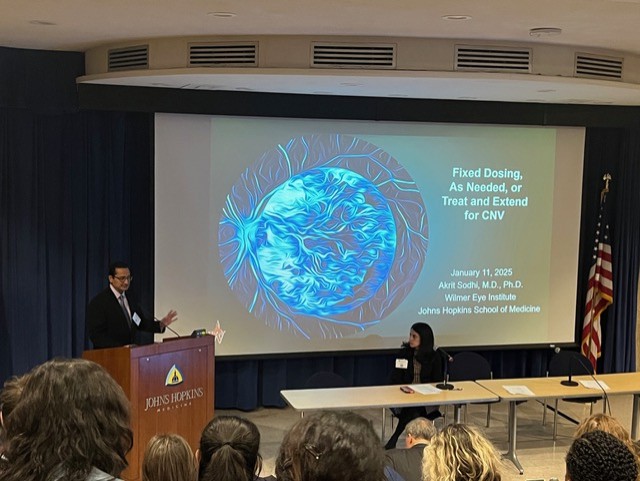Edward (Ned) Lu
Mass Eye & Ear
The Choroidal Neovascularization session was moderated by Lucia Sobrin, MD, MPH, Akrit Sodhi, MD, and Andre Witkin, MD.
Dr. Akrit Sodhi from Wilmer presented “Fixed Dosing, As Needed, or Treat and Extend for CNV.” He discussed the three treatment paradigms and the assumptions made by each regimen, focusing on treat and extend (TAE) versus as needed (PRN). He then described the treat-and-extend pause/monitor (TEP/M) protocol, a hybrid of PRN and TAE approaches that can reduce the number of treatments significantly over 2 years. This approach effectively weans nvAMD patients off anti-VEGF therapy (Cao, JCI, 2022). In addition, aflibercept more effectively weaned nvAMD patients off therapy compared to bevacizumab, and 90% of patients extended to 12 weeks entered a treatment pause (Cao, JCI, 2023). In summary, the TEP/M protocol is a proactive approach that optimizes the efficacy of a drug for each patient while minimizing the number of injections, and does not require treatment for patients who are quiescent. Like the other protocols, TEP/M requires close monitoring for evidence of disease activity.

Dr. K. Bailey Freund from VRMCNY/NYU then presented “Polypoidal Choroidal Vasculopathy: Special Considerations.” He emphasized that polypoidal choroidal vasculopathy (PCV) is a disease feature rather than a diagnosis, and that the “polyps” in this disease are dilated new vessels originating from type 1 neovascularization. He discussed how anti-angiogenic therapies may be effective long-term to reach large membranes with aneurysms in several locations. Finally, Dr. Freund posited that photodynamic therapy may have limited duration of benefit with the potential to increase angiogenic drive due to the angio-occlusive mechanism of action.
![]()
Finally, Dr. Andre Witkin from Tufts University presented “Safety Considerations: Inflammation / Occlusive Vasculitis.” He discussed non-infectious intraocular inflammation (IOI) that can occur after any type of injection or after any number of injections. IOI can range from mild to severe and rarely be associated with occlusive retinal vasculitis (ORV). Dr. Witkin showed several cases of IOI w/ ORV after anti-VEGF (brolucizumab, faricimab, aflibercept), vancomycin (vancomycin-associated hemorrhagic ORV (HORV)), and pegcetacoplan.
![]()
Anti-VEGF-associated ORV is often delayed (>1 week), can present after the first injection, involves arteries more than veins, can demonstrate arteriolar sheathing as the only exam finding, and can demonstrate choroidal ischemia. HORV is a more severe form of ORV that usually occurs after a single injection with predominantly vein>artery occlusion. Venular sheathing may be present, hemorrhages may be diffuse, sectoral, or perivenous, and IOP is often elevated with the potential to develop NVG rapidly. Regarding the diagnosis and management of ORV, clinicians need to consider endophthalmitis and utilize multimodal Imaging including FA. Regarding treatment, it is important to consider anti-inflammatory medications, vitrectomy to remove the inciting agent, and monitor for neovascularization. Finally, it is important to report adverse events.
Read All Atlantic Coast Retina Club / Macula 2025 Articles:
Mystery Cases 1 & 2
Mystery Cases 3 & 4
Mystery Cases 5 & 6
Mystery Cases 7, 8, 9
Imaging, GA, and IRDs
Keynote Lectures
DR and DME
Choroidal Neovascularization
Retinal Vascular Diseases
Ocular Oncology
Special Topics & Women in Retina